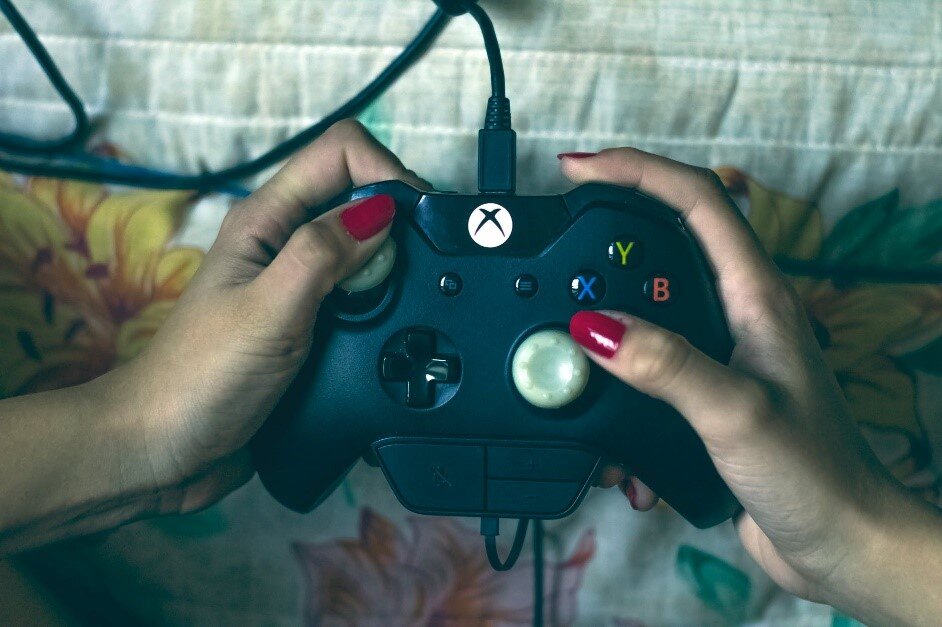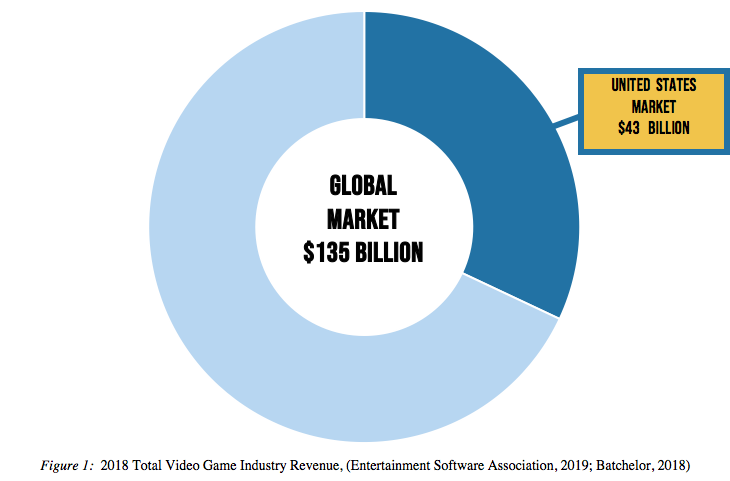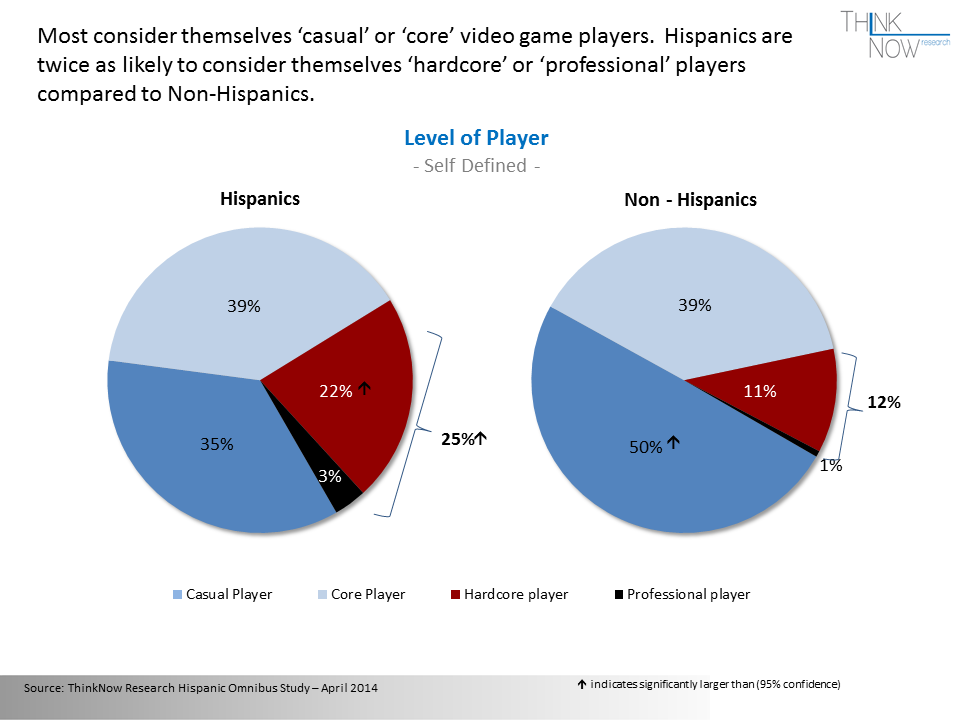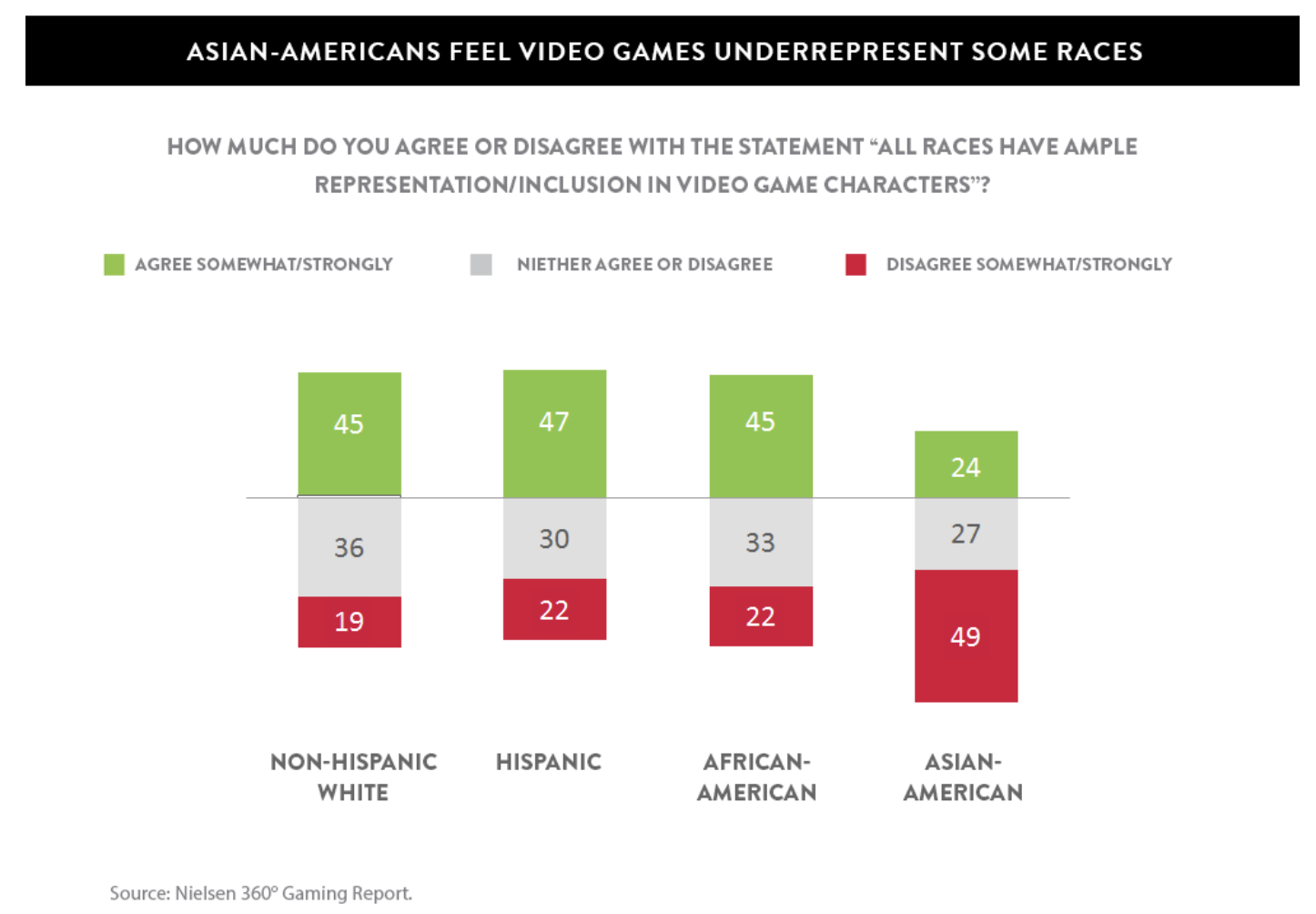This is part 1 in a three-part series exploring the inclusivity problem in the video gaming industry. To learn more about fixing the problem, read part 2 here. For recommendations for building inclusivity in video games, read part 3 here.
The video game industry expanded rapidly in the last decade with the U.S.A games market exceeding revenues of $43 billion in 2018. While there is growth, the industry is also facing an increasingly apparent and problematic disparity among audiences. In many traditional PC and console genres, women and non-white ethnicities are underrepresented both among the player-base as well as on-screen; furthermore, the player experience for underrepresented players is markedly different than their over-represented white male counterparts.
Image of a gamer. Source: Bruno Henrique
For example, this disparity is evident in the hugely popular massive online battle arena (MOBA) genre, which has a 90% male player-base. Likewise, in the United States, 67% of the gaming audience identifies as white/Caucasian. Even for genres and specific games with more equitable gender or ethnic distribution like massively multiplayer online role-playing games (MMORPGs), first-hand accounts of harassment or social toxicity are prevalent.
The industry is faced with some important questions for market expansion and future viability. First, what is pushing underrepresented groups (i.e. women and non-white ethnicities) away from the gaming medium? Second, how can developers and publishers provide a better experience for women and minorities who do engage with the medium? By failing to capture wider audiences, publishers of core games forfeit substantial potential revenues, and by failing to foster less-toxic communities, they put existing revenues at risk. A better understanding of: (1) diverse player motivations; (2) perspectives and preferences toward game content; and (3) pressing issues within gaming communities can enable publishers and other industry stakeholders to make more informed, culturally-sensitive decisions in the development, marketing, and management of their games, which should in turn lead to greater profits.
Video Game Industry & Trends
The video game industry has experienced tremendous growth: the total U.S. game industry revenue exceeded $43 billion in 2018, an 18% increase over the previous year. U.S. game revenues account for about 32% of the global market, which totaled approximately $135 billion in 2018. Though it was once considered a mere subset of the toy industry, gaming is now a legitimate entertainment medium and a booming industry eclipsing both box office and streaming video subscription 2018 revenues, which are respectively estimated at $41.7 billion and $28.8 billion.
2018 Total Video Game Industry Revenue. Source: Batchelor, 2018. Entertainment Software Association, 2019.
The game industry can be segmented in several ways. It is commonly grouped by device or platform: mobile (i.e. phone/tablet); console (e.g. Xbox, PlayStation, Nintendo Switch); PC (e.g. Steam); and handheld (e.g. Nintendo 3DS, PlayStation Vita). It can also be segmented by genre, of which there are many. According to a 2017 Statista report, the most popular game genres were, at the time (in descending order, by share of units sold):
shooter
action
sports
role-playing
adventure
racing
fighting
strategy
Genres can generally be categorized as either “casual” or “core”: casual games tend to be more accessible or simplistic, while core games lean toward complexity, competitiveness, or difficulty.
Though they are not completely aligned, these segmentations tend to correspond—the mobile interface lends itself better to certain genres falling closer to the casual end of the spectrum, while PC and console gaming err more toward core games and players. Unlike legacy linear media, the term genre in the game industry refers less to aesthetic or narrative theme and more to the core gameplay loop—the mechanics with which players interface from moment to moment while playing the game. For example, the shooter genre is defined by the act of aiming and shooting guns or other long-range weaponry, whether in a first-person or third-person perspective.
Game genres are neither fixed nor mutually exclusive. It is extremely common for a game from one genre to utilize elements from another (e.g. a first-person shooter employing character-building mechanics originating from the role-playing genre). Additionally, new genres and subgenres emerge with somewhat regularity as professional and amateur developers iterate on existing mechanics. For example, the MOBA and battle royale subgenres—currently two of the most popular types of games—stemmed out of mods (amateur-developed modifications to existing games) built on the strategy and shooter genres, respectively.
An increasingly-common monetization model in the game industry, and a key revenue driver, is the Games-as-a-Service (GaaS) model, in which consumers not only purchase or download the product, but also remain engaged, spending money on microtransactions. GaaS games are supported by developers with consistent content updates for an indefinite period after launching. Games utilizing this model are typically funded by ongoing microtransactions—piecemeal purchases of in-game items like loot boxes, player skins, and characters. Ubisoft founder and CEO, Yves Guillemot, referred to GaaS games as “service-based platforms where we can continually interact with and entertain our players.” Many of the most popular titles on the market utilize this model, including League of Legends, Fortnite, and Apex Legends.
Another industry trend to be aware of is esports, which refers to professional, organized, competitive gaming. In esports, games and players are divided into leagues, franchises, and teams, similar to traditional sports. Despite increasing investment into esports organizations, this report views esports as an extension of traditional, non-professional gaming (i.e. playing for fun). Game publishers tend to view esports as marketing for their core business of selling software. For the purposes of this study, diversity issues within esports are highly magnified symptoms of diversity issues within the broader game industry.
Core games suffer from a lack of inclusivity to varying degrees regarding gender and ethnicity. This is true for the audience, industry, and in the characters within the game world themselves. Moreover, a culture of toxicity exists within online in-game communities and third-party communities peripheral to them, like Twitch.tv, Reddit, and 4chan, where discussion and streaming occurs. Problematic social movements like white supremacy and the alt-right share disturbing overlaps with gaming culture.
By failing to address issues of problematic content and toxic online interactions, developers and publishers of many core and online games are failing to attract wider audiences and fostering a stunted culture, thus missing potential revenue and putting some existing revenue at risk.
Current Status of Gender Inclusivity/Equality Within the Gaming Community
Gender representation and equality is an issue that has been the focus of much inquiry and consideration in the gaming community. In an effort to investigate the presence of sexism in games, a study conducted by Indiana University analyzed in-game content of 571 games that were released between 1983 and 2014. The study found that the number of overly-sexualized female characters heightened in the mid-1990s, likely as a result of burgeoning technological advancements in 3D graphics. However, focused efforts to address and mitigate both: (1) the disproportionate underrepresentation of female characters and storylines in games, and (2) the misogyny women gamers encounter in gaming communities have been less prevalent. The industry’s failure to eradicate the prominent misogyny rampant in games and gaming communities has fostered an unwelcoming community for women.
Studies like those undertaken by Teresa Lynch and the International Game Developers Association, referenced subsequently in this section, have shown that some of the most visible issues stemming from misogyny are lack of uneroticized female characters in games, lack of women in the gaming workforce, and female player harassment. Research shows women gamers is the fastest growing market segment in the gaming industry. As more and more women become immersed as members and consumers within the game industry, it is imperative that toxicity targeted toward women be prioritized and addressed promptly.
A study conducted by researcher Teresa Lynch gathered data on 571 female characters in games from 1989 to 2014 (Lynch, Thompkins, van Driel, & Fritz, 2016). Her analysis concluded that although female characters are being overtly sexualized less and less, they are currently being hypersexualized at higher frequencies than those of male characters. There is also a discrepancy in the ratio of male to female characters featured in games. A separate study conducted by Feminist Frequency discovered that of the games showcased during 2016 Electronic Entertainment Expo (E3), only 3% of them had female protagonists while 41% had male protagonists. The implication here is that major developers continue to disproportionately construct male and female characters in game designs and narratives. Along with this disparity within the games themselves, there has also been a wide divergence between the percentage of women that are involved in the gaming community and the percentage of women that are employed within the industry. A survey conducted by the International Game Developers Association found that 22% of the workforce is female compared to 75% male despite the fact that women’s global market share of the gaming industry far exceeds 22%. The scarcity of women in the gaming industry workforce likely impacts the number of diverse portrayals of female game characters.
When considering the treatment of female gamers, there are numerous publicized instances of harassment while playing games online. Some of the more egregious occurrences have been archived by a website called “Fat, Ugly, or Slutty” which includes rape and murder threats, lewd propositions and images, and stalkers. In addition to many instances of harassment being individually publicized by victims, there are also cases that have brought the treatment of women in gaming to the forefront of discussion in the community; perhaps most notable is the “Gamergate” controversy. In 2014, in a harassment campaign dubbed #GamerGate, numerous women in the gaming community known for being vocal about the toxicity within the industry were systematically targeted. One of the high-profile women that was targeted during Gamergate was Anita Sarkeesian—founder of Feminist Frequency, a web series (and later website) where Sarkeesian freely comments on gender, racial, and sexual identity inequalities in the media, including video games. Other women who also experienced targeted harassment as a result of Gamergate were game developers/programmers Zoe Quinn and Brianna Wu, and actress and self-proclaimed gamer, Felicia Day. Most of the harassment involved rape threats, death threats, and the distribution of highly private and identifying information (i.e. home addresses, phone numbers, and social security numbers), also called doxing. Faced with brutal online harassment, many women have felt forced to adopt strategies such as leaving game sessions, disguising their gender, or simply not playing games at all.
As the gaming industry continues to rapidly-expand, both in terms of playership and profitability, gender demographics within the industry are beginning to shift. Playgroundz, a video game data analytics and research platform, released the Leisure Economy Research Study which found that women are increasingly taking a larger share of the game marketplace with an estimated 49% of the share in 2018 and a projected market share of 50% in 2019. Meanwhile, certain areas within the gaming industry do not reflect this near-equity of the market share between genders. For example, in esports and YouTube, women only make up 22% and 30% respectively.
Numerous female-forward online communities are currently combating the toxicity in gaming and have emerged to provide a safe haven to fellow female gamers. These communities include Feminist Frequency, Girl Gamer Galaxy, and Not in the Kitchen Anymore. Increased action and engagement will require more dynamic strategies to combat misogyny in a market where men and women are still treated differently. Not only should the toxic treatment of women incentivize the gaming industry to combat misogyny, but women’s growing purchasing power is also on the line.
Current Status of Racial and Ethnic Inclusivity/Equality Within the Gaming Community
Research has been done on the lack of diversity and inclusion within the gaming profession as well as representation within games themselves regarding the characters. However, topics focused on toxicity within online gaming on the consumer side are limited and consist primarily of editorials. Platforms like PlayStation, Xbox and Twitch do not release statistics on demographics of their user base or harassment claims making it harder to monitor any progress or lack thereof.
Definitive research on how much money is potentially foregone in the gaming industry due to toxicity problems is scarce/non-existent. However, Nielsen’s 2018 report on the digital lives of black consumers offers a glimpse of what those numbers could look like. African-American buying power is expected to grow to $1.5 trillion by 2022 in the U.S. alone due to increases in population, income, and education. Among teens, 73% of African-Americans 13 and older report playing video games compared to 66% of the total population. A study done by ThinkNow Research reported that Hispanic gamers buy or rent games more than non-Hispanics. They also consider themselves to be ‘hardcore’ or ‘professional’ gamers compared to non-Hispanics.
Hispanics are twice as likely to consider themselves ‘hardcore’ or ‘professional’ players compared to Non-Hispanics. Source: ThinkNow Research Hispanic Omnibus Study
In terms of diversity of video game characters, a 2015 Nielsen study found that 65% of multicultural gamers felt that characters were not representative of their specific group, especially those that identified as Asian-American. In fact, nearly half of gamers think there is lack of racial representation in in video game characters. A study by an Ithaca graduate was done in 2014 examining racial and gender representation in video games. White protagonists were prevalent in the top 50 games of 2014 at 67%, while Black and Asian characters represented 3% and Latinos 1%. Meanwhile, underrepresented groups are generally more engaged as gamers. The following is a breakdown of gamers by group:
· Asian-Americans at 81%,
· African-Americans at 71%
· Non-Hispanic whites at 61%
Percentage of gamers who agree with the statement that “All races have ample representation/inclusion in video game characters.” Source: Nielsen 360 Gaming Report
A developer satisfaction survey released by the International Game Developers Association in 2018 suggests that although developers recognized the importance and need for diversity within gaming, the industry continues to fall short. The developer breakdown from the survey is as follows:
· 68% identified as white/Caucasian/European,
· 18% identified as East Asian,
· 5% identified as Hispanic/Latino,
· 1% identified as African-American.
Only 3% of non-white developers are in senior positions within video game roles compared to 23% of their white counterparts.
Ethnicity of video game developers globally. Source: IGDA Developer Satisfaction Survey
In response to the lack of diversity within the industry and the toxicity found in online gaming, organizations have started to support underrepresented groups. Jay-Ann Lopez founded Black Girl Gamers (BGG), a safe space built for female gamers of color. Community members share video game content on Facebook, Twitter and Twitch, and support each other while playing popular games like Overwatch, Fortnite, Until Dawn and others. Lopez created this space after experiencing harassment in online gaming forums and platforms targeting her race and gender. She explains, "I didn't have many women or men or friends who were on my feed that I could play with…the people that I did play with would make jokes that I didn't appreciate as a woman, or I didn't appreciate as a Black woman.” With much of the buying power being in the hands of ethnic groups, creating safe and inclusive spaces in online gaming is more important than ever before.
About the Authors
This analysis was part of a capstone project by CMU Master of Entertainment Management Students: Mingyu Bian, Carina Carbetta, Olivia Green, Dan Hoyt, Joan Rodriguez.
Unlinked Resources
Lynch, T., Thompkins, J. E., van Driel, I. I., & Fritz, N. (2016). Sexy, Strong, and Secondary: A Content Analysis of Female Characters in Video Games Across 31 Years. Journal of Communication, 1-21.






